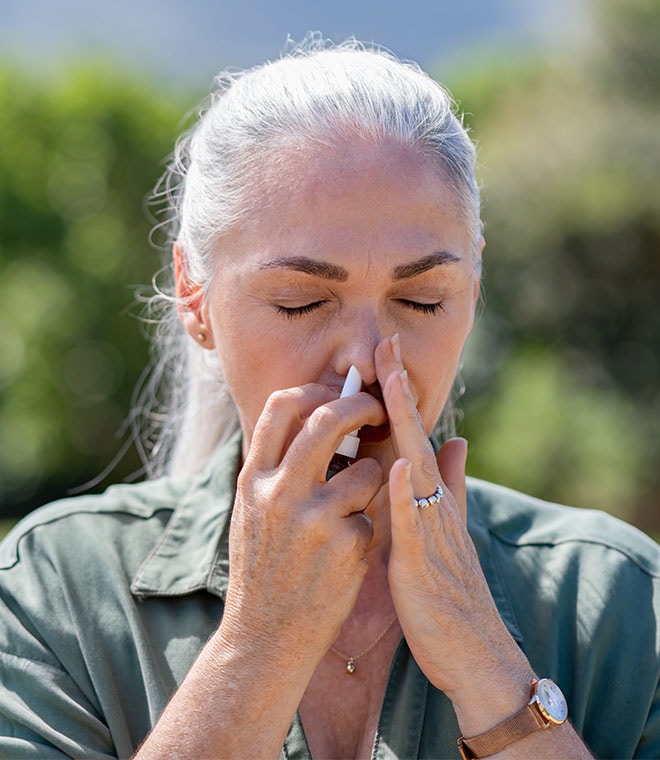Health
Tree pollen and other pollen allergies
By Jenilee Matz, MPH Sep 11, 2023 • 6 min
If you have a runny nose, sneezing and red, watery eyes every spring, tree pollen may be to blame. Tree allergies are common during the first half of the year. You may start to experience tree pollen allergy symptoms as early as January if you live in the South, or as late as May or June if you live in the Northeast. We'll break down the basics of tree pollen and other types of pollen, including grass and ragweed.
What is tree pollen?
Pollen is the male fertilizing agent of trees, grasses, weeds and flowering plants that's mostly yellow in color. Tree pollen, in particular, is light and can be transported by wind for several miles. This makes it easy for the fine particles to enter your nose, sinuses, lungs and eyes, and cause symptoms if you're allergic to tree pollen.
Not all trees have pollen. Some trees that cause the most allergy symptoms include the following:
- Alder
- Ash
- Aspen
- Beech
- Birch
- Boxelder
- Cedar
- Cottonwood
- Elm
- Hickory
- Mountain elder
- Mulberry
- Oak
- Olive
- Pecan
- Poplar
- Willow
Pollen allergy symptoms
Sometimes referred to as hay fever, pollen allergies can cause unpleasant symptoms. Note that while there are different types of pollen, tree pollen allergy symptoms, ragweed allergy symptoms and grass allergy symptoms are similar and can each cause:
- Sneezing
- Runny nose and increased mucus production
- Stuffy nose or nasal congestion
- Itchy eyes, nose, mouth, throat and ears
- Watery or red eyes
- Swelling around the eyes
Grass allergies can also cause skin rashes, including hives and welts.
In many cases, pollen allergy symptoms are uncomfortable but not serious, lasting for a few weeks one or two times per year. However, sometimes pollen allergies can lead to more serious complications, such as sinus infections. Allergies can also trigger asthma symptoms in people with asthma.
What is ragweed pollen?
Ragweed is a weed that grows mostly in the eastern and midwestern U.S. Ragweed flowers mature in late summer, and warm air, humidity and wind after sunrise cause them to release pollen. The pollen travels through the air to fertilize seeds so a new plant can grow for the following year. Ragweed allergies affect about 15% of Americans, and symptoms can last between six to 10 weeks, depending on your location. Ragweed allergy symptoms usually go away when the first frost of the season kills ragweed plants.
Grass pollen allergy
Allergies to grass pollen are common because the pollen easily spreads with the wind. In most parts of the U.S., grass pollen allergy season occurs between April and early June. Only a small number of grass species are known to cause allergies, including Bermuda grass, Bahia grass, Johnson grass, Kentucky bluegrass, rye grass, Timothy grass and fescue grass. However, many parts of the U.S. have an abundance of at least one of these grasses.
Relief for pollen allergy symptoms
Reducing your exposure to pollen can help keep bothersome symptoms at bay. Try to stay inside on hot, dry and windy days, because this is when pollen is at its peak. Pollen levels tend to be lower in the late afternoon and after heavy rain.
It's also a good idea to use the air conditioner and keep the windows to your house and car closed. This can help keep pollen out. In addition, investing in a high-efficiency particulate air (HEPA) filter specifically made for allergy sufferers may help. These fit in your furnace or car filter and trap the pollen in a fine mesh.
Pollen can also collect on clothing. After you’ve been outside, remove your clothes and shower to get the pollen off your clothes and hair. Instead of hanging clothes outside on a line to dry, use a dryer or hang up clothing inside. If you have a grass pollen allergy, wear a pollen mask when you mow your lawn, or ask someone else to mow it instead.
If these actions aren't enough to ease your pollen allergy symptoms, consider seeing your healthcare provider. They can help pinpoint the exact cause of your symptoms and recommend a treatment plan. Over-the-counter allergy medications can also help control pollen allergy symptoms. It's a good idea to begin taking these medications before the start of allergy season to help avoid symptoms. Talk to your healthcare provider or pharmacist to find a medicine that best suits your needs.
Clinically reviewed and updated September 2023.
Sources:
- https://www.aaaai.org/tools-for-the-public/allergy,-asthma-immunology-glossary/pollen-defined
- https://community.aafa.org/blog/tree-pollen-spring-s-first-allergy-offender
- https://acaai.org/allergies/types-allergies/pollen-allergy
- https://www.aaaai.org/tools-for-the-public/conditions-library/allergies/mowing-down-your-grass-allergies
- https://www.aafa.org/ragweed-pollen/
- https://medlineplus.gov/magazine/issues/spring13/articles/spring13pg22-23.html
- https://acaai.org/allergies/types/food-allergies/types-food-allergy/oral-allergy-syndrome
- https://www.mayoclinic.org/diseases-conditions/hay-fever/in-depth/seasonal-allergies/art-20048343



